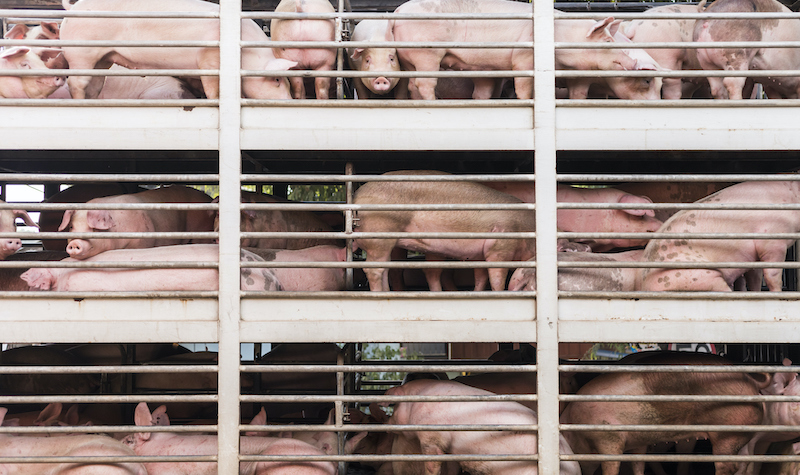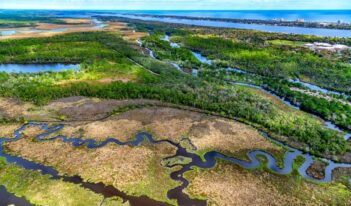
Experts say that EPA’s limited authority over concentrated animal feeding operations perpetuates pollution.
Millions of animals in the United States are raised in high-density, industrialized agricultural facilities known as concentrated animal feeding operations (CAFOs). These facilities produce low-cost meat, eggs, and milk as well as millions of tons of animal waste. For instance, a CAFO with 800,000 pigs produces 1.6 million tons of waste annually, or 150 percent of Philadelphia’s annual sanitary waste.
Most CAFOs dispose of waste using lagoon and spray-field methods. CAFOs drain waste, such as feces, urine, blood, and wastewater, through the floors of animal confinement spaces and into holding tanks. From the tanks, the waste is flushed into outside storage basins, called lagoons, which can reach the size of football fields and store several tons of animal waste. Periodically, CAFOs use high-pressure sprayers to apply liquefied waste to spray-fields, where the waste fertilizes growing crops.
CAFOs’ method of waste disposal can pollute nearby waters, especially during storms that cause overflowing of lagoons and runoff from fields. The Centers for Disease Control and Prevention has reported that problems in storing and managing high volumes of CAFO waste “affect ground and surface water quality” and have a “direct impact on human health and welfare for communities.” A recent working paper by economists Zach Raff and Andrew Meyer found a “large scale link that CAFO growth leads to worsening water quality.”
The U.S. Environmental Protection Agency (EPA) regulates waste discharge from CAFOs into the waters of the United States using the National Pollutant Discharge Elimination System (NPDES). Under the Clean Water Act, EPA issues NPDES permits for the lawful discharge of certain waste. All other discharges are illegal.
Three limitations restrict EPA’s regulatory authority over CAFOs. First, CAFOs must meet size thresholds before EPA requires NPDES permits. Second, EPA must show that waste from a CAFO has entered the waters of the United States before the agency can require an NPDES permit. Finally, the agricultural stormwater exemption prevents the agency from requiring NPDES permits for runoff caused by precipitation from CAFO spray-fields, even when that runoff reaches the nation’s waters.
Because of these limitations, EPA generally regulates neither small CAFOs nor large CAFOs that pollute only through overflowing lagoons or runoff from spray-fields. This Saturday Seminar explores critiques of EPA’s regulation of CAFO waste disposal.
Regulatory Shortcomings
- In a new research paper, William Hines of the University of Iowa College of Law identifies two limitations to EPA’s CAFO regulations. First, courts have struck down EPA rules that regulated CAFO discharges more strictly. Courts vacated EPA rules issued in 2003 and in 2008 that required NPDES permits for all CAFOs “with the ‘potential’ or ‘proposing’ to pollute.” Similarly, courts rejected EPA’s rule that required lagoons “to withstand a 100-year, 24-hour rain event” and that treated spray-field runoff as regulated pollution rather than exempt agricultural stormwater runoff. Second, in 47 states, EPA has delegated authority for “issuing and enforcing NPDES permits to CAFOs” and for “regulating CAFOs not required to hold NPDES permits” to state water pollution control agencies. Hines argues that the solution to these regulatory limitations is technological rather than legal; to prevent water pollution, agricultural engineering technology must advance beyond lagoon and spray-field methods of waste disposal.
- In a recent report published by the National Resources Defense Council, Duke University School of Law’s Lee Miller and Earthjustice’s Gregory Muren argue that EPA has pervasive gaps in its knowledge about CAFOs and the animal agriculture industry. Because no federal agency currently collects or maintains data on CAFOs, Miller and Muren argue that the federal government is unable to hold the industry accountable for the air or water pollution to local communities. To remedy federal regulators’ lack of knowledge, Miller and Muren suggest reinstating former reporting obligations that required CAFOs to provide information on existing animal operations every 10 years and encouraging states “to demand transparency and accountability of the CAFOs within their borders.”
- Although precipitation-related discharges from spray-fields are currently excluded from NPDES permit requirements under the agricultural stormwater exemption, EPA has not plainly defined the exemption, Emily Kenyon explains. In a note published in the New York University Law Review, Kenyon critiques Alt v. EPA, in which a district court held that the agricultural exemption included waste runoff from CAFO production areas in addition to spray-fields. Kenyon contends that the reasoning in Alt is faulty and inconsistent with EPA’s implied intent to apply the stormwater exception narrowly. To correct the error, Kenyon argues that EPA should adopt a rule defining agricultural stormwater.
Alternative Accountability Mechanisms
- In an article in the Journal of Animal and Environmental Law, attorney Hank Graddy argues that the laws now regulating CAFO runoff were initially adopted to compensate for inadequate pollution remedies. Focusing on his experience advocating for Kentucky residents living near hog farms, Grady writes that most CAFOs have nonetheless managed to escape compliance with federal laws and cause “adverse environmental impacts.” Graddy argues for increased citizen action through litigation to achieve more effective environmental protection requirements. Federal environmental protection laws will regulate CAFOs more effectively “as citizens complain and as courts lose patience with the agency deference to look the other way,” according to Graddy.
- Federal drinking water law favors water filtration and cleanup by utilities providers over pollution prevention by farms, Margot J. Pollans of the Pace University School of Law explains. In a paper published in the Ohio State Law Journal, Pollans argues that current systems for providing safe drinking water are inefficient, unfair, and disproportionately harm low-income and minority communities. To address these issues, Pollan argues for legal reforms delegating pollution mitigation to farmers, encouraging local utilities to protect their source waters, and revoking the special status of farms in environmental law.
- Laws originally designed to govern small family farms shield many multinational corporate giants engaged in agribusiness from regulation, Harvard University’s Charlotte E. Blattner and the University of Zurich’s Odile Ammann argue in an article in the Journal of Food Law and Policy. These corporations benefit from “a considerable degree of self-regulation,” Blattner and Ammann write, which leads to industry practices reflecting different priorities than those reflected in legislative standards. This de facto immunity from the law has global repercussions, as “intensified animal agriculture threatens and violates the human rights to food, water, a safe environment, land, and animal protection,” Blattner and Ammann argue. They claim that these human rights guarantees can be used to hold governments accountable for exempting damaging agribusiness activities from regulation.
The Saturday Seminar is a weekly feature that aims to put into written form the kind of content that would be conveyed in a live seminar involving regulatory experts. Each week, The Regulatory Review publishes a brief overview of a selected regulatory topic and then distills recent research and scholarly writing on that topic.



